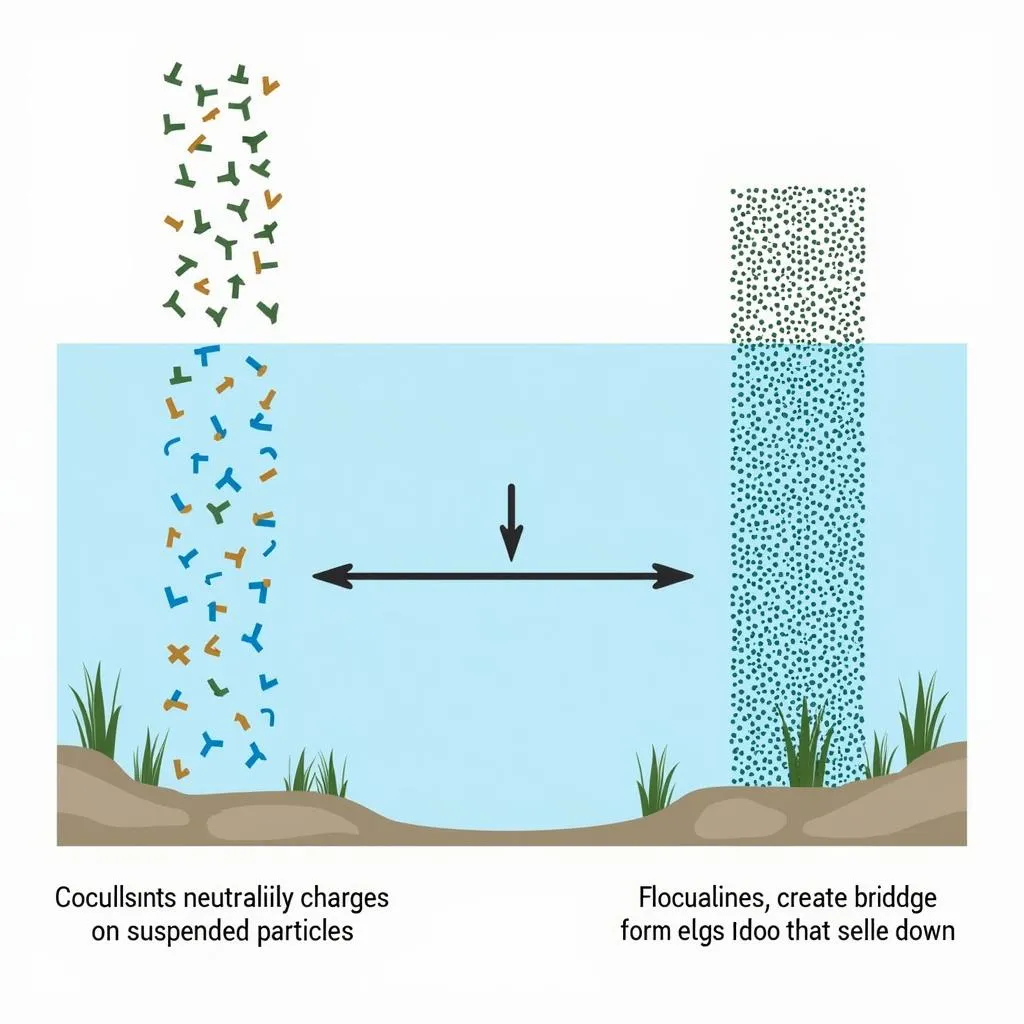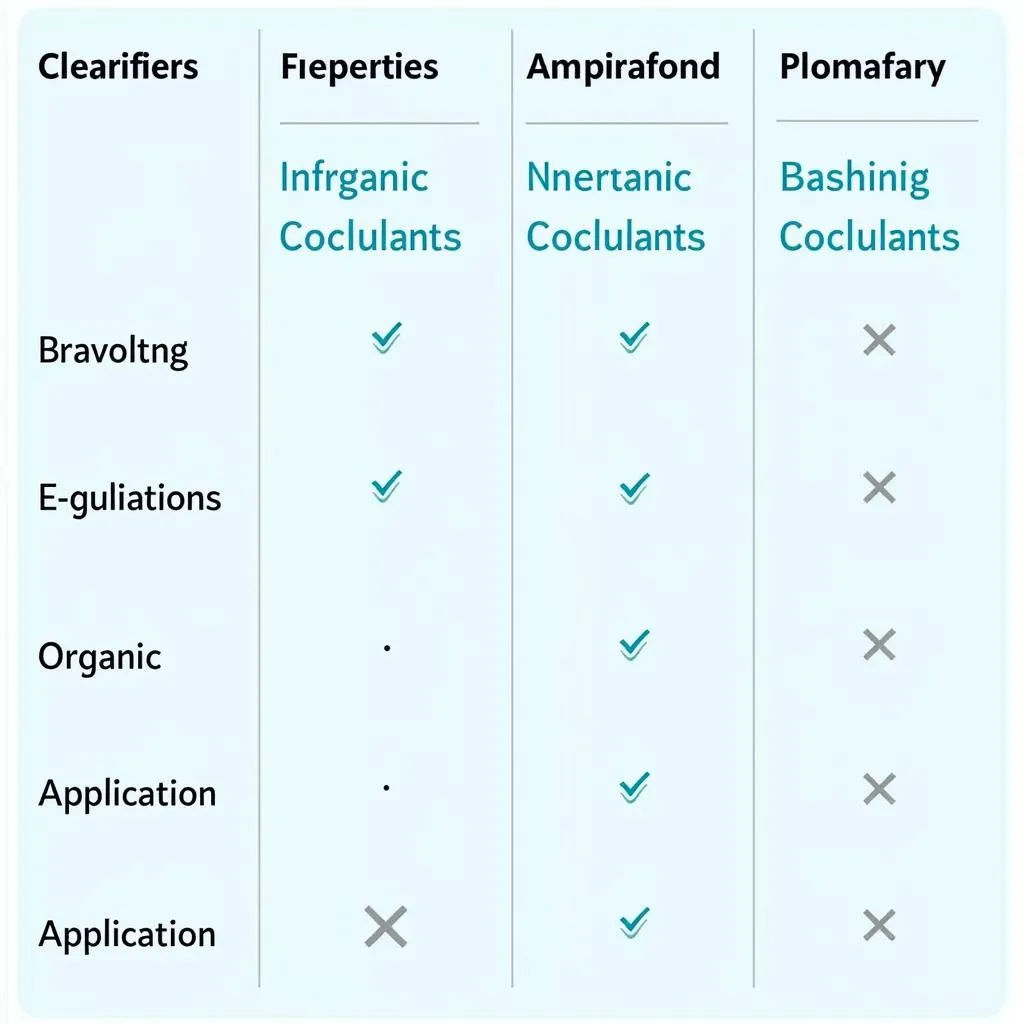Chemical clarifiers, also known as flocculants and coagulants in English, are essential components in various water and wastewater treatment processes. These chemical agents play a crucial role in separating suspended solids and impurities from liquids, ensuring cleaner and safer water for different applications.
Unraveling the Science Behind Chemical Clarifiers
Chemical clarifiers function by altering the surface properties of suspended particles, encouraging them to clump together. This process, known as flocculation and coagulation, facilitates the efficient removal of contaminants from water.
Flocculation: Bridging the Gap Between Particles
Flocculants are long-chain polymers that introduce bridges between small, dispersed particles. Imagine these polymers as tiny threads that connect and bind individual particles, forming larger and heavier aggregates called “flocs.” These flocs, due to their increased size and weight, settle down more readily, making it easier to separate them from the liquid.
Coagulation: Neutralizing the Charge
In contrast to flocculants, coagulants neutralize the electrical charges on the surface of suspended particles. These particles, often carrying negative charges, repel each other, hindering their aggregation. Coagulants, typically metallic salts like aluminum sulfate (alum) or ferric chloride, introduce positive charges that counterbalance the negative charges. This neutralization reduces the repulsive forces, allowing the particles to come closer and form larger clumps.
 Chemicals for wastewater treatment
Chemicals for wastewater treatment
Applications of Chemical Clarifiers Across Industries
The versatility of chemical clarifiers extends beyond water and wastewater treatment, finding applications in various industries:
- Drinking Water Treatment: Ensuring safe and potable water by removing turbidity, color, and harmful microorganisms.
- Wastewater Treatment: Treating industrial and municipal wastewater to meet regulatory discharge standards.
- Pulp and Paper Industry: Enhancing the efficiency of paper production by clarifying process water and reducing fiber loss.
- Mining Industry: Separating valuable minerals from ore slurries and managing tailings water.
- Food and Beverage Industry: Clarifying beverages like juice, beer, and wine to enhance clarity and stability.
Types of Chemical Clarifiers: A Closer Look
Chemical clarifiers are broadly categorized into inorganic coagulants, organic coagulants, and flocculants. Each type exhibits specific properties and suitability for different applications.
Inorganic Coagulants: Traditional and Effective
Inorganic coagulants, like alum and ferric salts, are widely used due to their cost-effectiveness and reliability. They effectively neutralize charges and initiate the coagulation process, especially in treating water with high turbidity.
Organic Coagulants: Environmentally Friendly Alternatives
Organic coagulants, such as polyaluminum chloride (PACl) and polyamines, offer advantages like lower dosage requirements and reduced sludge generation. Their biodegradable nature makes them a more environmentally friendly option compared to inorganic counterparts.
Flocculants: Enhancing Floc Formation and Settling
Flocculants, mainly polymers like polyacrylamide and polyethyleneimine, act as bridging agents to enhance floc formation. Their addition improves the settling characteristics of flocs, leading to faster and more efficient solid-liquid separation.
 Types of water clarifying chemicals
Types of water clarifying chemicals
Factors Influencing Chemical Clarifier Selection
Choosing the appropriate chemical clarifier depends on several factors:
- Water Quality: Turbidity, pH, alkalinity, and the nature of contaminants present influence the choice of clarifier.
- Treatment Objectives: The desired clarity, removal efficiency, and regulatory compliance requirements dictate the selection.
- Cost and Availability: Economic considerations and the accessibility of specific chemicals play a role in the decision-making process.
Importance of Proper Dosage and Control
The effectiveness of chemical clarifiers hinges on precise dosage and control. Overdosing can negatively impact water quality and increase costs, while underdosing may not achieve the desired treatment outcomes.
Jar Tests: Determining Optimal Dosage
Jar tests are laboratory procedures conducted to determine the optimal dosage of coagulants and flocculants for a specific water sample. By simulating the treatment process in a controlled environment, jar tests help optimize chemical usage and ensure treatment effectiveness.
Monitoring and Control Systems: Ensuring Consistent Performance
Continuous monitoring and control systems play a vital role in maintaining the desired water quality. These systems measure parameters like turbidity, pH, and flow rate, automatically adjusting chemical dosing to compensate for fluctuations in water characteristics.
Safety and Environmental Considerations
While chemical clarifiers are crucial for water treatment, handling and disposal require careful consideration due to potential environmental and health risks.
Safe Handling Practices: Protecting Workers and the Environment
Strict adherence to safety protocols, including the use of personal protective equipment and proper storage, is paramount when handling chemical clarifiers. Proper training for personnel involved in handling and dosing these chemicals is essential to minimize risks.
Environmental Impact and Mitigation: Sustainable Water Treatment
The discharge of treated water containing residual chemicals can impact aquatic life and ecosystems. Implementing effective treatment strategies, such as coagulation and flocculation optimization, minimizes chemical usage and reduces the environmental footprint of water treatment processes.
Conclusion: Chemical Clarifiers – Essential for Water Quality
Chemical clarifiers play a pivotal role in providing clean and safe water for various applications. Understanding the science behind their function, exploring different types, and considering safety and environmental aspects are crucial for effective and sustainable water treatment.
FAQs About Chemical Clarifiers
1. What are the common side effects of using chemical clarifiers in drinking water treatment?
When used appropriately and within regulated limits, chemical clarifiers used in drinking water treatment pose minimal health risks. However, excessive aluminum residuals from alum usage have been linked to potential health concerns. Water treatment plants employ various methods, including filtration and pH adjustment, to minimize aluminum residuals in drinking water.
2. Are there natural alternatives to chemical clarifiers for water treatment?
Yes, natural coagulants like Moringa oleifera seeds and chitosan derived from crustacean shells have shown promising results as sustainable alternatives to chemical clarifiers. Research and development in this area continue to explore and optimize the application of natural coagulants for water treatment.
3. How can I dispose of unused or expired chemical clarifiers safely?
Contacting your local hazardous waste disposal facility is crucial for the safe and responsible disposal of unused or expired chemical clarifiers. These facilities have the necessary protocols and expertise to handle and dispose of hazardous materials, preventing environmental contamination and potential risks.
4. Can I use chemical clarifiers in my swimming pool?
While chemical clarifiers are used in water treatment, their application in swimming pools requires careful consideration. Pool water chemistry differs significantly from drinking or wastewater, and using inappropriate chemicals can disrupt the balance, leading to cloudy water, irritation, or other issues. Consult with a pool professional for guidance on maintaining optimal water quality in swimming pools.
5. Where can I find more information about chemical clarifiers and their applications?
Reputable online resources, scientific journals, and industry publications provide comprehensive information about chemical clarifiers. Websites of chemical suppliers and water treatment organizations often offer valuable insights into specific products and their applications.
If you have any further questions or require assistance with water treatment solutions, please don’t hesitate to contact us. Our team of experts is available 24/7 to provide guidance and support. You can reach us at 0373298888, email us at [email protected], or visit our office located at 86 Cầu Giấy, Hà Nội.
Explore our website for more informative articles on various water treatment topics:
- Công ty con của tập đoàn hóa chất
- Hóa chất Asahi
- Chất hóa học gây cười
- Hóa chất Crew cách dùng
- Hóa chất pha cà phê cực độc
We are committed to providing you with the latest information and cutting-edge solutions for all your water treatment needs.